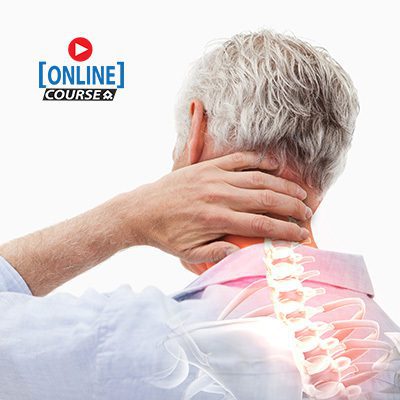Cervical Spine Online Bundle
Course Description
You will receive access to seven online courses, equalling 13.8 Contact Hours.
Diagnosis and Management of the Cervical Spine – 7.5 Contact Hours – an in-depth look at primary and secondary pathoanatomy, biomechanics, basic and specific clinical examination and interpretation, management suggestions, and specific approaches to diagnose and treat cervical-related disorders.
The Cervical Puzzle: Putting the Pieces Together – 1 Contact Hour – This course introduces the clinician to a method of assessing and understanding clinical patterns associated with specific cervical spine problems both related to structure and movement. The insights complement all therapy paradigms, and the learner will come away with an idea of where this fits in their day-to-day clinical setting. Help your patient best navigate the waters of cervical spine pain for the most successful outcomes.
Case Study: Cervical Spine Patient Diagnosis, Treatment, and Outcomes using the IAOM-US Systematic Approach – 1.8 Contact Hours – This course provides a look at the IAOM-US systematic approach toward a specific case of the cervical spine so you can understand how joint-specific testing and concepts of treatment and patient education that we teach at the IAOM-US supports an excellent outcome for your patients.
A Physical Therapist’s Guide to Cervical MRI Images – 0.5 Contact Hours – This online course will teach you everything you need to know for you to understand what you see on the image as well as explain it to your patient. This lecture is geared towards assisting clinical diagnosis as well as helping each clinician feel more comfortable navigating cervical MRIs
Using Disc Hydration Principles to Heal the Intervertebral Disc – 1.5 Contact Hours – This presentation will address intervertebral disc pathophysiology, degeneration processes, and the healing potential, and which positions, movements, and lifestyle could help strengthen the disc and preserve its health. Some strategies to limit the effects of spinal stenosis will be discussed, as well as in the treatment of people with back pain and nerve root compression syndrome.
Rapid ID of neck pain – 0.5 Contact Hours – This short course is packed with information related to patient history and clinical presentation that guides the examiner to a precise clinical working diagnosis of the three most seen musculoskeletal disorders in the neck region: disc protrusions, facet arthropathy, and cervicogenic headache. Each pathology is linked with suggested management strategies that match precise treatment to the specific problem.
Case Study – Cervical Spine – 1 Contact Hour – This case study takes you through a common patient example and walks you through each component of a patient. Starting with the subjective, proceeding through the examination and dissecting the interpretation in a way that makes it easy to understand and able to replicate on your next cervical patient. This case study is great for those who have taken the live cervical course and want a refresher and for those who want to see what the IAOM approach is about.
Objectives and Goals
Diagnosis and Management of the Cervical Spine
- Given a case study of one of the most common musculoskeletal pathologies of the cervical complex with consequent clinical dysfunctions, the learner will independently integrate the anatomic, physiologic, and biomechanical findings into a differential diagnosis report.
- Accurately identify at least one common clinical dysfunction of the cervical spine in 3 different patient scenarios.
- Identify three effective treatment interventions for acute, recurrent, and chronic cervical dysfunctions and related pathologies.
- Design a treatment plan for a patient with acute dysfunction of the cervical spine.
- Design a treatment plan for a patient with recurrent or chronic cervical spine dysfunctions.
The Cervical Puzzle: Putting the Pieces Together
- Identify the role of discs, joints, and myofascial structures in presenting cervical pain.
- Choosing the specific physical therapy strategy to reduce pain
- Assists pain interventionalists in establishing a starting point for procedural medicine.
- Locate hypermobile versus hypomobile segments, allowing for stabilization of the hypermobile and mobilization of the hypomobile segments.
- Reactivate the sensorimotor system during manual therapy management
- Transition from structural treatment to functional treatment using functional examination and corrective strategies
Case Study: Cervical Spine Patient Diagnosis, Treatment, and Outcomes using the IAOM-US Systematic Approach
- Find the articular pillar
- Do joint-specific testing for cervical hypomobilities
- Perform specific treatment manipulations correctly
- Educate your patient on how they can relieve pain and increase mobility at home
A Physical Therapist’s Guide to Cervical MRI Images
- Determine which MRI type is best for assessing disc pathologies as well as bony changes
- Orient yourself to clinically relevant anatomy in the sagittal and axial planes
- Develop a process of viewing cervical images to ensure consistency and ease of viewing
- Assess common cervical pathologies in the sagittal view as well as axial view
- Guide your patient through their imaging with more confidence
Using Disc Hydration Principles to Heal the Intervertebral Disc
- Explain intervertebral disc pathophysiology and degeneration processes
- Identify strategies to preserve disc health
- Determine appropriate postures and movements to preserve disc health
- Develop strategies to strengthen the disc
- Identify when to hydrate/dehydrate the disc based on pain patterns and patients’ characteristics.
- Provide an example of the management of patients with nerve root compression syndrome.
Rapid ID of neck pain
- Identify pain patterns specific to the three most common musculoskeletal problems in the cervical spine.
- Clinically differentiate the most common musculoskeletal pain generators in the cervical spine.
- Confidently perform and/or recommend management strategies for these musculoskeletal conditions.
Case Study – Cervical Spine 1
- Identify potential cervical pain generators based on the pain drawing
- Apply the IAOM-US algorithm for exam interpretation to have a better understanding of potential pain generators
- Differentiate between facet joint and disc involvement
Pre-approved in the following states
Contact info@iaom-us.com to verify approval in your state. Please contact us if you hold a Florida license.
For Pre-Approvals see the PDF - Continuing Education Accreditations & Approvals Requested and/or Received by Organization: Download PDF File
Disclosures:
- Financial: The instructor(s) receive an honorarium for presenting this course.
- Non-financial: The instructor(s) have no relevant non-financial relationships to disclose.
- Partial credit is not available. For online courses, passing module assessments and completing the course evaluation is required to earn continuing education credit. For live courses, attendance is confirmed by signing the attendance sheet at the course; ensure name and professional license number are accurate, and initial both morning and afternoon attendance.
Instructor

Valerie Phelps
Instructor

Jean-Michel Brismée
Instructor

Phillip S. Sizer Jr.
Instructor

Esteban Azevedo
Price
- $249
| I understand it is my responsibility to confirm the IAOM-US has CCUs approved for this course in my state and/or inform IAOM-US what is required to obtain CCU approval. Please review our policies for Refunds, Cancellations, EULA |

